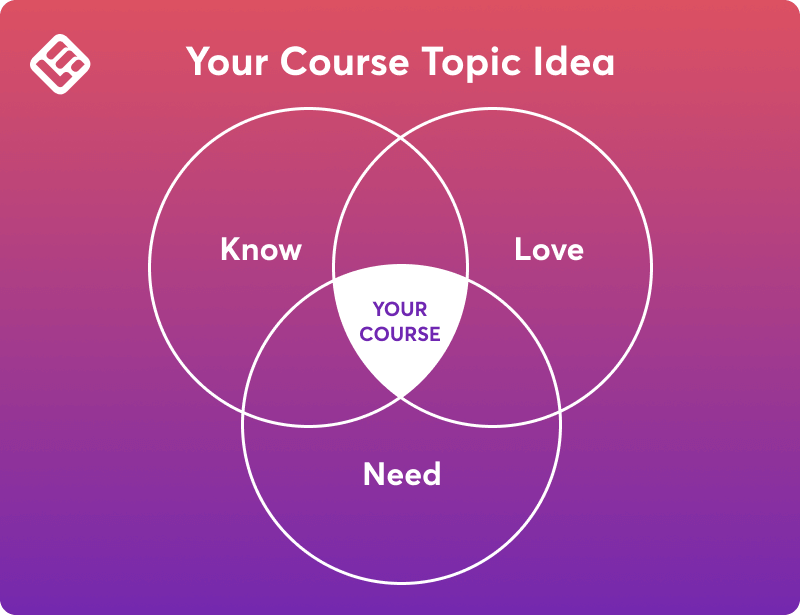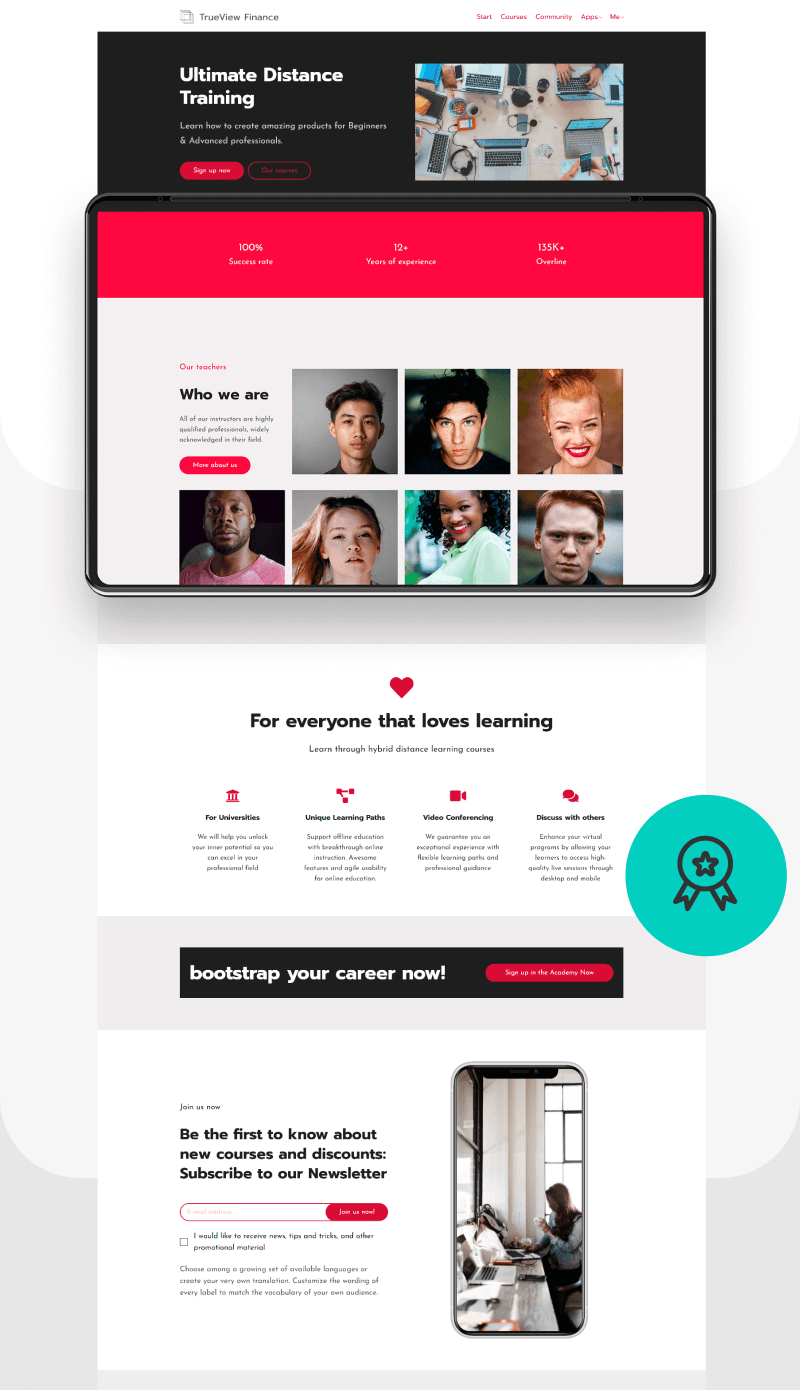Table of Contents
The demand for online education is growing fast, making now a good time to start your journey as a course creator and sell online courses.
With the growing knowledge economy, creating and selling an online course is a solid opportunity right now. The elearning market is expected to reach $319 billion by 2029 (Source: Elearning Statistics), and it’s clearly a strong market.
Whether you want to generate passive income, build authority in your industry, or create a thriving online course business, this guide will take you through each step.
Why selling online courses is a smart business model
Selling online courses lets you earn passive income by creating an online course once and selling it many times with minimal extra effort. This model offers unlimited scalability since online courses can reach students worldwide without logistical barriers.
By sharing your knowledge, you help others develop personally and professionally while positioning yourself as an industry expert. This opens doors to many opportunities, including consulting, keynote speaking, business partnerships, and collaborations with other industry professionals.
As you can see, there are many reasons to sell an online course, but here are three of the most important ones, each with the potential to build a profitable business:
Monetize your audience: As a content creator, you already have an engaged audience and several revenue streams from ads, an e-shop, or subscriptions. Offering an online course lets you deepen your relationship with your audience while providing valuable educational content. It serves as an additional, scalable revenue stream that complements your existing business model.
Build an online education business: If your core business involves selling online courses, training programs, coaching services, or educational products, you are likely looking for ways to scale your sales, expand your reach, or move from offline teaching to an online platform. Creating a strong online presence helps you attract a broader audience, streamline course delivery, and create a sustainable revenue stream.
Monetize your expertise as a side income: If you have a full-time job or run a business but want to supplement your income, creating an online course can be a good opportunity. It lets you turn your existing knowledge and skills into a scalable digital product that generates revenue with minimal ongoing effort. Whether you want to establish a secondary income stream or gradually transition into a full-time education business, the option to create online courses provides flexibility and financial growth potential.
How can you choose a profitable online course topic?
A successful online course starts with picking the right topic. Begin by identifying your expertise, professional background, and passions to determine what knowledge you can confidently teach.

Market demand is another key factor. Do online research, study search trends, and analyze competitor offerings to validate demand. You can use tools like Google search ads to understand what learners are actively searching for.
Checking online course marketplaces and course platforms will help you see what’s already selling well and how you can make your course different. Talking directly with your target audience through surveys, social media, or forums will give you valuable insights into the specific challenges they want to overcome through your course.
How can you validate your online course idea?
Before putting a lot of time and resources into online course creation, it’s important to follow a structured course validation process to test your course idea. Run surveys or polls through email lists, social media, or niche online communities to gather feedback from potential students.
Try starting with a free webinar or a short mini-course to see if people are interested and willing to invest in your content. You can also join online forums and industry discussions to get a feel for how eager people are to learn about your area of expertise.
Looking at engagement and responsiveness in these settings can be a good indicator of course viability.
How can you create engaging course content?
The success of your online course depends on the quality and structure of your course curriculum design. A well-organized curriculum ensures smooth progression, making it easier for students to follow along and stay motivated throughout the course.
Video course creation: delivering high-quality lessons
Engaging video lectures significantly improve retention rates, so it’s important to invest in good lighting, sound, and camera quality. High-production-value videos make your course more professional and appealing. If needed, you can enhance production using free video editing software to refine your content, add subtitles, and improve overall clarity. Structuring your videos into digestible modules with a logical flow helps learners absorb information effectively.
Enhancing learning with additional materials
Supplementing video lessons with additional course materials such as PDFs, worksheets, and quizzes ensures a well-rounded learning experience. Providing structured handouts, cheat sheets, and practical exercises can help students reinforce key concepts and retain information better. Including case studies and real-world examples makes your content more relatable and actionable.
Keep your learners engaged and motivated
To keep your learners engaged and motivated, make your course interactive. Add elements like assignments, live Q&A sessions, discussion boards, and peer collaboration activities to encourage participation and deeper learning. Gamification through quizzes, badges, and completion certificates can also keep learners committed and motivated to progress.
Also, remember that building a sense of community is key. Encouraging discussions and progress-sharing helps learners stay engaged, leading to higher course completion rates and overall satisfaction.
By focusing on well-structured course content, engaging video lessons, and interactive student experiences, you can create a compelling learning journey that drives student success and establishes your course as a go-to educational resource.
Prefer to learn visually? Check out our step-by-step video on how to create an online course with our platform:
How can you select the best online course platform?
Choosing the right online course platform is crucial for delivering your content effectively. There are several options available, each with its own pros and cons, depending on your business goals and technical expertise. If you’re considering long-term scalability, you may also want to explore membership sites for courses, which provide ongoing value to learners through exclusive content and community engagement.
Here’s a quick comparison of the three leading online course platforms in the market:
To explore a detailed comparison of course platforms, including their pros and cons, you can also check out our LearnWorlds vs. Teachable vs. Thinkific vs. Kajabi guide.
Depending on your business needs, you can also consider online course marketplaces like Udemy and Skillshare. These platforms can expose your course to a broader audience, but they may impose restrictions on pricing and revenue sharing.
Another approach is using WordPress learning management system (LMS) plugins, such as LearnDash and WPLMS. If you already have a website, adding an LMS plugin can provide flexibility and customization. However, managing these plugins requires additional costs for hosting, maintenance, and technical support, making them more complex to maintain compared to an all-in-one platform.
If you are looking for a more streamlined solution, self-hosted LMS platforms like LearnWorlds, Teachable, Kajabi, Podia, and Thinkific offer a comprehensive package, including course creation tools, marketing automation, and integrated payment systems. These platforms allow for greater control over branding, pricing, and audience engagement while eliminating the need for complex technical setups.
LearnWorlds specifically, offers an all-in-one solution, providing user-friendly interfaces, marketing tools, AI course creation tools, and seamless integrations to help you streamline your online course business.
How can you price your online course effectively?
Pricing your online course is a crucial factor in its success. There are multiple ways to structure your pricing model, and choosing the right one depends on your market positioning and revenue strategy. Understanding different course pricing strategies can help you determine whether a one-time payment, subscription model or tiered pricing approach is the best fit for your offering.
Always keep in mind that your pricing strategy should not only reflect the course value but also align with your business goals and audience expectations.
For more details, check out our guides on high-ticket courses and pricing strategies for online courses.
How to create a high-converting sales page
A compelling course landing page is crucial for converting visitors into paying students. Clearly articulating the course value by highlighting the benefits and learning outcomes will help prospective learners see how the course will solve their challenges.
Including social proof, such as testimonials and case studies from previous students, builds credibility and reassures potential buyers. A strong call-to-action (CTA) should be prominently placed to encourage immediate sign-ups. Additionally, optimizing your landing page with engaging visuals, clear messaging, and mobile-friendly design improves conversion rates, making it easier for visitors to commit.

Be sure to read our complete guide on writing a course landing page, check out the examples here, and if you are looking for more, you can check Course Masters for tutorial courses from successful course creators and experts on selling and marketing online courses.
How can you market your online course?
A well-planned content marketing strategy is essential for a course creator to attract students and increase course sales. Aim for content monetization, so leveraging content marketing through blog posts, YouTube videos, and social media allows you to position yourself as an authority while attracting organic traffic.
How can you launch and scale your online course business?
Launching your online course is just the beginning. To build a sustainable and thriving online course business, you need a solid strategy to generate leads, drive traffic, and optimize your sales funnel. Below are the key steps to successfully scale your course business.
Generate leads with effective lead magnets
Leads are potential customers who have shared their contact details with you, often in exchange for valuable content. A lead magnet is a powerful way to attract these leads and build your email list. Some effective lead magnets include:
By promoting these lead magnets through social media, email marketing, or paid ads, you can build a strong pipeline of potential students who are already interested in your expertise.
Drive traffic to your lead magnets
Once you’ve created your lead magnet, the next step is to drive traffic to it. Here are some proven strategies:
Automate your email sales funnel
After capturing leads, use email marketing automation to nurture them into paying students. A structured email sequence can guide potential customers through their decision-making process. Key email sequences include:
To help you move faster, we already have an email sequence to sell your course. Combine that with the rest of your marketing strategy and content marketing efforts on social or through your own website for the penultimate results.

You can download these email sequence templates we have prepared to launch an online course. All you need to do is choose your favorite email marketing software and set the sequence to automatically go to anyone who downloaded your lead magnets:
Marketing activities to support your sales funnel
Expanding your digital product sales can further boost your online course business by offering complementary resources such as ebooks, templates, and exclusive content bundles. These digital products provide additional value to your students while creating multiple revenue streams beyond your course enrollments.
Scaling your course requires consistent marketing efforts. Here are essential marketing activities to keep your funnel full:

Effective promotional strategies for course sales
To drive consistent course enrollments, implement these promotional tactics:
After you sell a course: retaining and upselling students
Selling a course is just the first step while delivering an exceptional learning experience ensures repeat business and referrals. Consider offering:
By exceeding expectations, you can turn first-time students into loyal fans who refer others and continue learning from you.
After successfully launching your first online course, the next step is scaling your business for long-term success. Expanding your offerings by creating new courses or bundling complementary content can encourage students to continue learning from you.
Establishing a thriving online community through an online forum or private group fosters student engagement and provides ongoing support.
Running limited-time promotions, discounts, and seasonal offers helps maintain a steady flow of new enrollments and keeps your business growing. Keeping your course updated with fresh content ensures that your material remains relevant and valuable over time.
How can you build your learning community?
Scaling your online course business for long-term success isn’t just about selling more courses—it’s about creating a strong foundation that keeps students engaged, coming back for more, and spreading the word. While marketing and content play a huge role, I want to highlight the importance of community in sustaining and growing your business.
A thriving learning community gives your course long-term value by fostering deeper relationships, encouraging peer-to-peer support, and increasing student retention. When learners feel like they’re part of something bigger, they stay motivated, interact more, and see greater value in your course.
So how do you create an engaged and supportive learning community? Here’s how:
For a more in-depth guide on building an engaged learning community, check out my article “From followers to fans: Proven strategies for building an engaged online community,” where I explore strategies, tools, and expert tips to help you create a thriving online space.
Remember, at the end of the day, a strong learning community is about connection. When learners feel supported, engaged, and valued, they’re far more likely to succeed—not just in your course, but in their overall learning journey. And as they succeed, so does your business.
Ready to create a lasting impact with your online courses?
Creating and selling online courses is more than just a way to generate revenue—it’s a powerful way to make an impact. By sharing your expertise, you’re not only helping others learn valuable skills but also shaping the future of your industry. Years from now, your dedication to teaching could evolve into something much bigger than you initially imagined.
What makes online courses truly special is the ability to not just educate but inspire. Your unique vision, insights, and passion become part of the learning experience, leaving a lasting impression on your students. The content you create today has the potential to influence future trends, spark meaningful discussions, and leave a digital legacy that continues to grow over time.
Every lesson, every learner, and every success story contributes to a larger narrative—one where you are at the center, guiding others toward knowledge and transformation. And with the right strategies, commitment, and tools, there’s no limit to how far your online course business can go.
Now is the perfect time to take action. Get started with your first online course today using LearnWorlds’ 30-day free trial and begin building a business that leaves a lasting impact.
Frequently Asked Questions (FAQs)
How do I create and sell my own course?
Creating and selling an online course involves research, validation, structured course development, choosing a course platform, marketing and continuous engagement with students.
Do I need a license to sell a course?
In most cases no, you don’t need a license to sell an online course. But specific industries like finance or healthcare may require certifications or disclaimers to comply with legal regulations.
Can you make money from courses?
Yes! Many course creators earn a good income from their online courses. With the right strategy you can earn passive income with courses and scale your business over time.
How to create a free online course?
You can create an online course for free by using free video editing software, hosting your content on affordable or free platforms and promoting your course through organic marketing strategies like blogging and social media.
Further reading
- Best Profitable Online Course Ideas & Trends with Examples
- How to Create a Membership Site
- 18 Best Online Course Platforms
- How Much Money Can You Make Selling Online Courses?
- Best Online Learning Platforms
- How to Teach Online & Earn Money
- How to Make Your Online Courses TikTok Famous: Your Guide to Success
Rosemary is LearnWorlds’ Content Marketing Manager. She has over 2 decades of experience in omnichannel marketing and content writing for the IT and SaaS industry. Her expertise lies in crafting effective content marketing strategies that attract, engage, and nurture customers, enabling LearnWorlds to reach its target audiences with precision.


